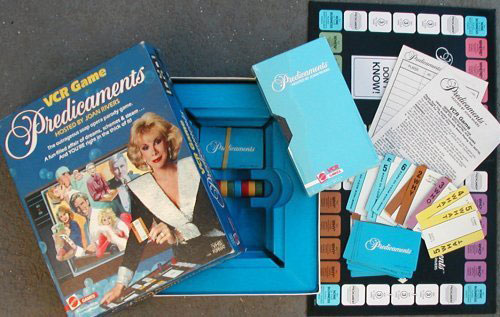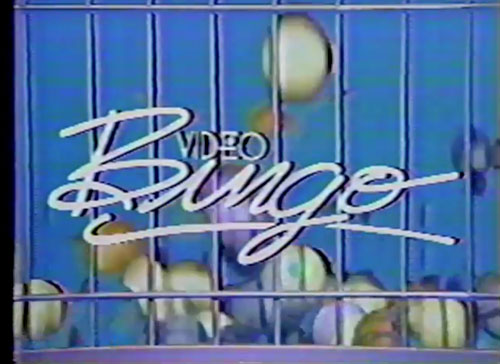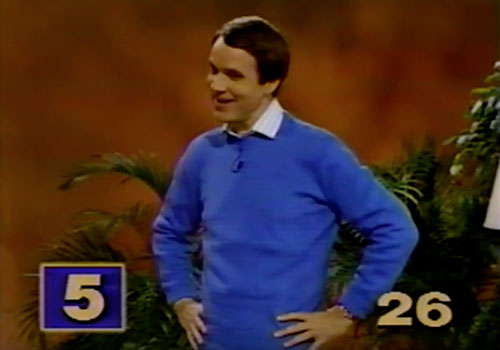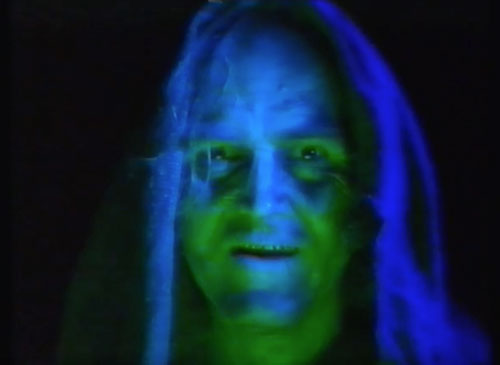VCR Plus Dice
From board games to stunted game systems, the many attempts to turn VHS into a platform for games ran into a big problem: There was only one way forward.
”Tedium combines the best of the 99% Invisible podcast and James Burke’s Connections TV show. It takes the invisible and makes it visible again and then connects it to the past and present creating a livelier picture than you ever knew existed.“
We have some cool stuff in the works, but we need your help! Sign up to support Tedium on Patreon at $5 or above and get something cool in the mail. Don’t miss out. (Thanks Mike Whalen, a $25 patron, for the testimonial.)
1974
The year that the first game based on an interactive film was first released, by (of all companies) Nintendo. The game, Wild Gunman, was an early arcade-based light gun game; players would shoot at a screen and attempt to shoot a cowboy before the cowboy shot back. (Here’s a sample of the film they used.) Unlike later light gun games made by Nintendo, the shooting was based on timing, rather than aim, because the whole screen would flash, instead of a specific part of it. The game was eventually remade for the NES and Famicom, though the interactive film element was set aside, in part because there’s no way the NES would have ever been able to do it justice.

Predicaments, a soap opera-themed VCR game starring Joan Rivers.
Why board games and VCRs were bound to converge in some way, shape, or form
By the mid-1980s, it was clear that VHS, not Beta (or any other secondaryformats) had won the battle for living room supremacy. The fact that there was suddenly a brand new medium to enjoy, that there was consensus on, did something interesting: It created new types of business, and not just for Hollywood studios looking for a place to sell their blockbusters.
Home video’s initial high cost created the rental industry, of course, but it also created a context for public domain films to live a second life. Instructional videos, whether fitness clips starring Jane Fonda or cheesy how-to videos, became big business and helped encourage the rise of new ways of selling stuff—think infomercials.
And then there were more esoteric ideas—like board games with a VHS element. Today, they may seem more like a novelty, but back then they were common enough that you could probably call them a full-on trend.
It’s worth considering the business context that led to this growing interest in VHS board games: Home video games, despite being arguably more functional and more interactive if not as graphically complex, seemed like they were a simple fad at the time the VCR board game became a phenomenon, around late 1985.
The Nintendo Entertainment System, still in its infancy and yet to be released nationally, had yet to prove itself on the market, but the VCR had—one estimate reported by The New York Times had the video cassette industry driving $3.3 billion in sales between rentals and purchases in 1985, a rate approaching the size of the film industry at the time. Go where the audience is, of course.
The other factor was the general approach taken often seemed to lean less on selling the VHS tape as the key element, and more the board game. In a 1986 New York Magazine article, Parker Brothers marketing manager John Call spelled this point out.
“We see these games not as a new way to use a VCR but as a new way to play board games,” he explained.
In 1985 and 1986, board games were proven. Video games weren’t.

If you find yourself playing this game, you’ve done something wrong with your life.
Five examples of games with a VHS element
- America’s Funniest Home Videos, the iconic Bob Saget-hosted TV show that I’ve noted having an affinity for, has a VHS board game that constantly asks players to pause after every clip to play the included game—a format that feels like would get maddening after a while.
- Ashes of Empire, a strategy game for DOS from the early ’90s, comes with an instructional video, because you know a computer game is easy to figure out when you’re given an instructional video explaining how to play it.
- The Three Stooges, whose VHS board game integrates the novelty hit “The Curly Shuffle” into the gameplay and added a bunch of onscreen graphics telling players how to make the next move. It appeared at the peak of the Stooges’ ’80s revival.
- Video Bingo, because Bingo is a better game when the numbers are called in the same order every time you play.
- Wayne’s World, which managed to get career-peak stars Dana Carvey and Mike Myers to tell you how to play the game you were trying to play.
“Is this like a video game? Sort of; but it uses the most powerful processor in the world—YOUR BRAIN!”
— The Dragon Master, from TSR’s DragonStrike board game. To understand the backstory, set the mood, and better introduce players to fantasy role-playing, the game used a VHS tape as the pre-game. Players watched the video—a mix of gameplay and stage production—then played a Dungeons & Dragons-style adventure, complete with polygonal dice, map boards and miniatures. DragonStrike has no shortage of cheesy music, early blue screen effects and scenery chewing. It’s silly and fun … but The Dragon Master is kind of pushy, don’t you think?

Let’s just admit that playing non-interactive video charades with Rich Little is nobody’s idea of fun, OK?
The difference between a bad VHS game and a good one
In a lot of ways, the concept of putting games against the backdrop of a non-interactive video shouldn’t have worked. It wasn’t like the video was going to change the next time you were going to watch it, right?
Watching a movie a second time around is one thing, but games simply require more dynamics. If every episode of Jeopardy featured the same answers, there would be no reason to watch.
And this was certainly a problem in some specific contexts. As I pointed out a couple years ago in my piece on Worlds of Wonder, the Action Max, which was a video game console of sorts but had most of the basic elements of a VHS board game, quickly failed on the market because its games’ replay value was basically zero. The games were all light-gun based, but unlike, say Duck Hunt, there wasn’t any randomization, so the game played the same way every single time.
(Also not helping: The Action Max required setup, and that setup was at the beginning of every tape. Just watch the first three minutes of this clip of the Action Max gameBlue Thunder and wonder to yourself if you’d want to stick with the game after going through all that setup.)
But perhaps a better way to think about this is in terms of karaoke. In a way, the traditional form of karaoke works not unlike a VHS board game does, in that the video is the same every time out. What makes karaoke a fun activity are two things: The singing and the people. (And the booze, but that goes without saying.)
Karaoke works because the process is obvious and doesn’t get in the way. You’re not bogged down by rules.
Unlike a traditional video game, which has to lift the entire concept of the gameplay based on what’s happening on the screen, the best VHS games use the video as something of an accent to the game’s construct. Apples to Apples is a fun game not because of the cards themselves, but because of the word combinations (and occasional dirty jokes) that the cards enable. In other words, the game works because you and your friends are at the center of the action.
But, of course, many VHS games did not do this very well.
New York writer Phoebe Hoban suggested that one of the games Parker Bros. was marketing, Eyewitness, was incredibly thin on the gameplay front: It was simply a bunch of video clips of historical events, in which players made up their own questions and answers. (Have two hours to kill? Here’s the full video on YouTube.)
“This sounds more like a high-school homework assignment than fun,” she wrote.
And that was a real danger. In a lot of ways, VHS games faced a similar challenge as edutainment, in that the games offered the illusion of something fun but could be mired in boring process due to the awkward shoehorning of an unnecessary element into the game.
Another curious entry in the genre that really underlines this point was Rich Little’s VCR Charades, which required players to figure out the charades that Little was doing before the people playing the game on the screen did. Rich Little may be a skilled impressionist, but at some point, one has to wonder whether it’d just be easier to play charades without the help of the guy on the screen.
In a 1985 article, The Baltimore Sun ripped on the game, pointing out that it’s “a contrived attempt to jazz up a party game that can be played for free,” and featuring a quote from a child that had more teeth than Little’s entire career (which is unfortunate because Little has had a long career).
Speaking of the feigned reactions from the onscreen players, the play-tester said: “This looks like we accidentally got somebody’s home movie from the Fotomat.”
But on the other hand, there were games that used their lack of interactivity to solid effect. The board game Atmosfear, perhaps one of the most popular board games with a video element, was a board game first and a VHS tape second.
The tape works as a framing element and the game was well-regarded for its time because of how it used the recording to increase tension during gameplay.

Guessing the salary needed to hire this guy was a lot lower than Rich Little’s fee.
“As players, nothing we did could affect him; the tape played back the same way every time. But that didn’t matter,” Den of Geek contributor Sarah Hobbs wrote in a tribute to the game. “What mattered was how we, as players, responded to the tape.”
The game sold more than 2 million copies worldwide in its first two years on the market, and was successful enough that a DVD version of the game was later made. It was even a bargaining chip when the company that owned the brand, J.W. Spear & Sons, found itself subject of a bidding war between Hasbro and Mattel. (Not the main one, of course—Spear owned the international rights to Scrabble.)
The VHS game wasn’t a perfect creative medium, but when a game nailed it the way Atmosfear did, the value of the medium proved itself.
It’s clear in retrospect but probably was less clear back then that the VCR board game was a half-solution, an attempt by people excited about technology to move things forward. The problem was, the elements just weren’t well-suited for the approach, but if those working on the idea had waited just a few years longer, the technology would catch up.
There’s a literal example of this involving an attempted video game system that relied on VHS. No, not ActionMax, another one.
Project NEMO, a Hasbro-funded attempt to take on Nintendo in the gaming sphere, had some high-profile players backing it, including Activision cofounder David Crane and Atari founder Nolan Bushnell, who was knee-deep in his home robot phase at the time. But the idea was really the product of a guy named Tom Zito, a one-time journalist who had the idea for a video game console based on film footage. The concept had the backing of the robot developers at Bushnell’s company Axlon, but the company didn’t have the development funds to pull off the concept. Hasbro, looking to take on Nintendo, did.
The system used multi-track VHS tapes that had data tracks allowed for more interactivity than standard video tapes. However, there were complications; Bushnell wanted a version for the arcades, something Crane resisted. And Hasbro didn’t like the way the project was headed under Axlon, which led Zito to work on it under another company.
In the end, the NEMO, also known as the Control-Vision, was never released. (A prototype of the system being tested in front of Hasbro execs appeared years later.) But a few years later, as full-motion video became a part of CD-based video game consoles, the idea suddenly made more sense—and two of the full-length interactive games that Zito worked on for the failed device, Night Trap and Sewer Shark, ended up getting released for the Sega CD and other CD-ROM-based consoles.
There was a context in which the ideas that VHS enabled worked. The problem was, in most cases, they were often just a touch too soon.
:format(jpeg)/2018/09/tedium091318.gif)
/2018/09/tedium091318.gif)

/uploads/ernie_crop.jpg)